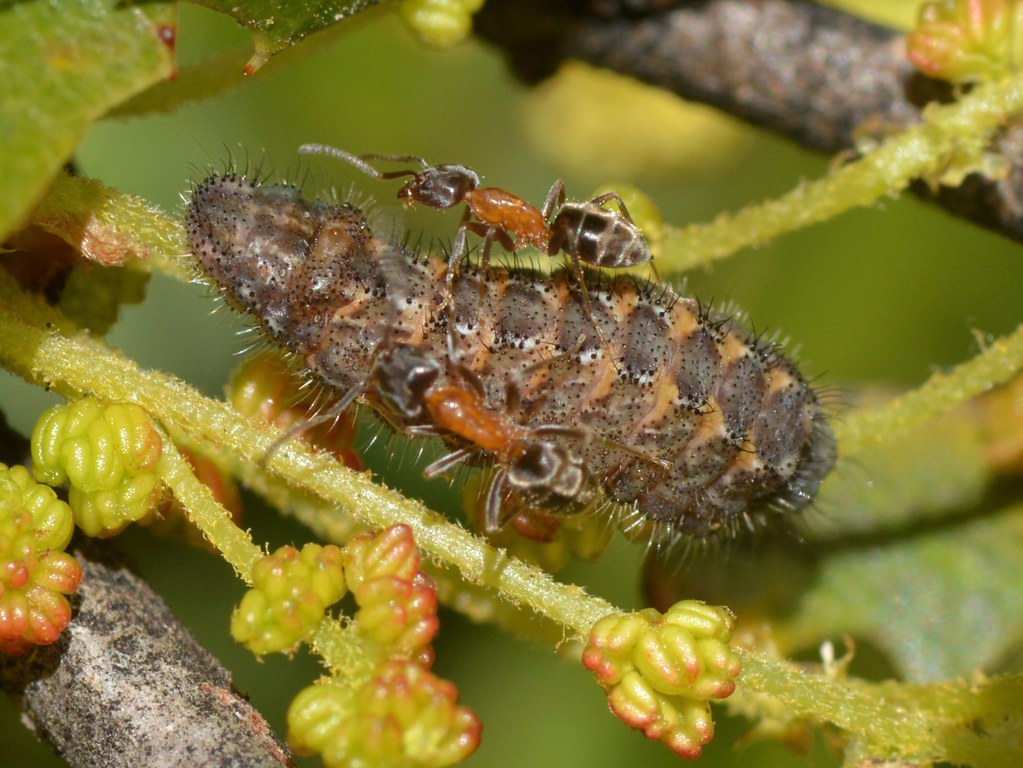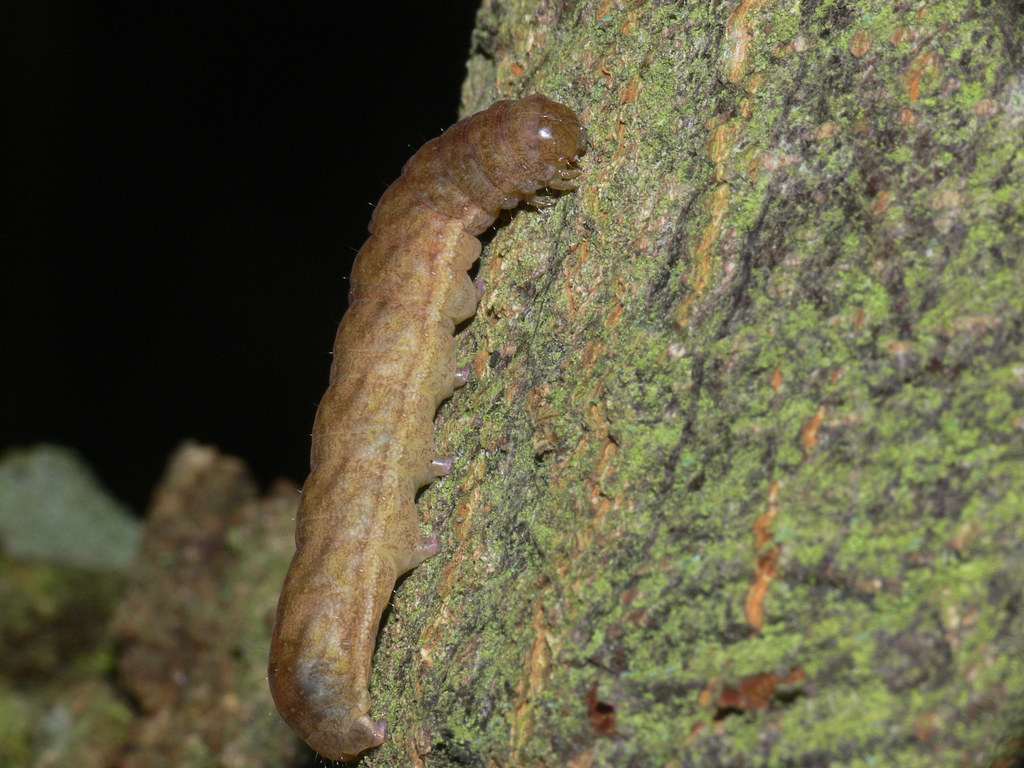Oak worms are a common problem for many homeowners. These pests can cause extensive damage to trees and shrubs and can be difficult to control. There are a few things you can do to get rid of oak worms and prevent them from coming back.
First, it’s important to remove any debris or dead leaves from around your trees. This will help reduce the number of places where the worms can hide and lay their eggs. Next, you’ll need to treat your trees with an insecticide designed specifically for oak worms.
Be sure to follow the directions on the label carefully, as over-application can harm your trees. Finally, keep an eye out for signs of infestation, and treat any affected areas as soon as possible. With a little effort, you can keep oak worms under control and protect your landscape.
- Look for signs of oak worms on your oak trees
- These include small holes in the leaves and branches, as well as silken webs around the affected areas
- If you find evidence of oak worms, prune off any affected branches and dispose of them properly
- Treat your oak trees with an insecticide designed specifically for caterpillars and other leaf-eating pests
- Be sure to follow the instructions on the label carefully
- Repeat this treatment every few weeks until the problem is under control and there are no more signs of oak worms on your trees
How Long Do the Oak Worms Last?
Oak worms are the larvae of the oak moth. They hatch in late spring or early summer, and their feeding period lasts for about six weeks. During this time, they can strip an entire oak tree of its leaves.
The damage caused by these pests can weaken the tree and make it more susceptible to disease and insect infestations. Oak worms are most active at night, so they are not often seen by homeowners unless there is a heavy infestation.
How Do I Get Rid of Oak Caterpillars Naturally?
If you have oak trees on your property, you may occasionally find caterpillars crawling on the trunk or leaves. These caterpillars are the larvae of moths and can cause damage to your oak trees if left unchecked. While there are chemical treatments available to kill caterpillars, you may prefer a more natural approach.
Here are some tips for getting rid of oak caterpillars naturally:
- Prune-infested branches. If you see caterpillars crawling on the leaves or branches of your oak tree, prune away those sections and dispose of them in a plastic bag. This will remove the catering population and prevent them from doing further damage.
- Use Bacillus thuringiensis (BT). BT is a bacteria that specifically targets caterpillars and other insects that feed on plants. It’s available in both liquid and powder form and can be sprayed directly onto infested areas.
- Introduce beneficial insects. Ladybugs, lacewings, and parasitic wasps all eat caterpillars, so releasing them into your garden will help keep the population under control. You can purchase these insects online or at many garden stores.
- Plant Caterpillar-Repellent Plants. Some plants emit chemicals that deter caterpillars from feeding on them. Examples include tansy, wormwood, rue, and garlic. Planting these around your oak tree can help keep caterpillars away.
- Apply Diatomaceous Earth. Diatomaceous earth is a powder made from fossilized algae. Its sharp edges cut through the exoskeletons of pests like caterpillars, killing them within 48 hours. Be sure to use food-grade diatomaceous earth for this purpose, as it’s the only type that’s safe for humans and animals.
What Do Oak Worms Turn Into?
Oak worms are the larvae of the oak caterpillar. The oak caterpillar is a type of moth that is found in North America. These caterpillars are known for their voracious appetite and their ability to defoliate oak trees.
The oak worm has a black body with white stripes running down its sides. It grows to be about two inches long. When fully grown, it will spin a cocoon and pupate inside of it.
After about two weeks, the adult moth will emerge from the cocoon and mate. The female moths will lay their eggs on the underside of oak leaves. The eggs will hatch into larvae within a few days and the cycle will begin again.
Are Oak Worms Harmful?
Oak worms are the larvae of moths in the family Noctuidae. They are harmful to oak trees because they bore into the bark and feed on the sapwood, causing the tree to weaken and die. In some cases, infestations can kill a tree within two years.
How to Get Rid of Oak Worms Naturally
Oak worms are the larvae of moths that lay their eggs on oak trees. The caterpillars hatch and feed on the leaves of the tree, causing extensive damage. If left unchecked, an infestation can defoliate a tree and weaken it, making it susceptible to disease and pests.
While there are chemical treatments available to kill oak worms, there are also several natural methods that you can use to get rid of them. One way to control oak worm populations is to remove their food source. This means regularly cleaning up fallen leaves and debris from around the base of the tree.
You can also prune off any infected branches. If possible, bring in organic matter such as mulch or compost to help discourage future infestations. Another effective method is to introduce predators into the area.
Ladybugs, lacewings, and parasitic wasps all feed on caterpillars and can help keep populations in check. You can purchase these beneficial insects from most garden stores or online retailers. Just be sure to release them near the affected tree so they can do their job!
Finally, you can try using a homemade spray made with water and dish soap or neem oil. These ingredients will kill oak worms on contact without harming other plants or animals in the area. Simply mix together 1 tablespoon of soap or oil per gallon of water and apply it liberally to any affected leaves or branches.
Oak Worms Texas
If you live in Texas, then you’re probably familiar with oak worms. These pesky critters are the larval form of moths that feed on oak leaves. While they’re not harmful to humans, they can cause serious damage to oak trees.
Oak worms typically appear in late spring or early summer. They start out as small, green caterpillars that are about an inch long. As they mature, they grow to be about two inches long and turn brown.
Oak worms typically have a dark stripe down their back and a light stripe along each side. While oakworms are most commonly found on live oak trees, they can also infest red oaks, white oaks, and post oaks. When there’s a heavy infestation, the caterpillars can strip a tree of all its leaves within just a few days!
This can weaken the tree and make it more susceptible to disease and pests. In extreme cases, an infestation can even kill a tree. If you think your tree has an infestation of oak worms, it’s important to contact a certified arborist or pest control professional right away so they can assess the situation and determine the best course of action for treatment.
What Do Oak Tree Caterpillars Turn into
As the weather gets warmer, you may start to see more caterpillars around. These Caterpillars are the larvae of moths and butterflies and go through four stages of life; egg, larva, pupa, and adult. The time it takes to complete these stages can vary greatly depending on the species.
For example, gypsy moth caterpillars take only one month to mature while monarch butterfly caterpillars take two months to grow into adults. One type of caterpillar you may encounter is the oak tree caterpillar. These voracious eaters can strip an oak tree of its leaves in just a few days!
But don’t worry, they’re not harmful to humans. In fact, these Caterpillars are actually quite interesting creatures. So what do oak tree caterpillars turn into?
Adult moths! The specific type of moth depends on the geographical location but in North America, the most common types are the Pandorus Sphinx Moth and the Io Moth. Both of these moths are large and have beautiful markings on their wings.
If you find a group of oak tree caterpillars devouring a tree near you, don’t be alarmed. It’s just nature taking its course!
How Long Do Oak Worms Live
Oak worms are the larvae of moths in the family Psychidae. The larvae live and feed on oak leaves, and can cause significant damage to trees if left unchecked. There are several species of oakworm, but the most common is the American oakworm (Phryganidia californica).
Oak worms typically hatch in late spring or early summer and begin feeding immediately. They will continue to feed for 4-6 weeks before pupating into adults. Adult moths emerge in late summer or early fall, mate, and lay eggs on the undersides of oak leaves.
The eggs hatch the following spring, starting the cycle anew. While Oak worms generally only live for one year, their populations can explode in any given year if conditions are favorable (plenty of food and no predators or parasites). This can lead to severe defoliation of trees, which can ultimately kill them.
Oak Worms in California
Oak worms are a type of caterpillar that feast on the leaves of oak trees. They are especially prevalent in California, where there are many oak trees. Oak worms can strip a tree of its leaves in just a few days, causing extensive damage.
In some cases, the damage caused by oak worms can kill a tree. Oak worms typically emerge in late spring or early summer. They are most active at night when they feed on the leaves of oak trees.
During the day, they hide in the crevices of tree bark or in leaf litter on the ground. When fall arrives, oak worms pupate and emerge as moths. There is only one generation of oak worms per year.
If you have an oak tree on your property, be sure to inspect it regularly for signs of oak worm activity. If you see any caterpillars or damage to the leaves, you should take action to control them immediately. There are several methods you can use to get rid of oak worms, including spraying them with insecticide or removing them by hand (if possible).
How to Get Rid of Caterpillars in Trees
If you have caterpillars in trees, there are a few things you can do to get rid of them. You can handpick them off the tree, which is time-consuming but effective. You can also use a pesticide, although this may not be ideal if you have other animals or children in the area.
Finally, you can try to attract natural predators like birds to your yard – they’ll help keep the caterpillar population under control.
White Worms in Oak Trees
White Worms in Oak Trees If you have ever seen white worms in oak trees, you may have wondered what they are and why they are there. These small, creamy-white creatures are the larvae of sawflies, a type of fly that is closely related to bees and wasps.
The sawfly larva feeds on the leaves of oak trees, skeletonizing them as it goes. This can cause significant damage to the tree if enough larvae are present. The good news is that there are natural predators that help keep sawfly populations in check, so infestations are usually not long-lasting.
If you do find yourself with a few white worms in your oak tree, simply prune off the affected leaves and dispose of them. No chemical treatment is necessary or recommended.
Frequently Asked Questions:
What is the best oak tree for caterpillars?
The best oak tree for caterpillars is the Quercus robur, also known as the English oak.
What plant attracts the most caterpillars?
Milkweed is known to attract the most caterpillars, especially those of monarch butterflies.
What kills most caterpillars?
Pesticides are the primary factor that kills most caterpillars, as they are often used in agriculture and gardening to control insect populations.
Conclusion
If you have oak trees in your yard, you may be familiar with the destructive little creatures known as oak worms. These pests can quickly strip a tree of its leaves, causing it to become weak and susceptible to disease. But don’t worry – there are a few things you can do to get rid of oak worms for good!
First, try spraying your trees with an insecticide specifically designed to kill caterpillars. You can also remove the worms by hand – simply pick them off the leaves and drop them into a bucket of soapy water. Finally, make sure to keep your trees healthy by watering and fertilizing them regularly; this will make them less attractive to oak worms and other pests.
Related articles:
Insect Invasion: Threat to Utah’s Fir Forests
 Dr Ahsanur Rahman, PHD
Dr Ahsanur Rahman, PHD
UK Forests Collapse Imminent: Act Now Against Climate!
 Dr Ahsanur Rahman, PHD
Dr Ahsanur Rahman, PHD
Lightning Strikes Threat: Boreal Fires Jeopardize Carbon
 Dr Ahsanur Rahman, PHD
Dr Ahsanur Rahman, PHD









